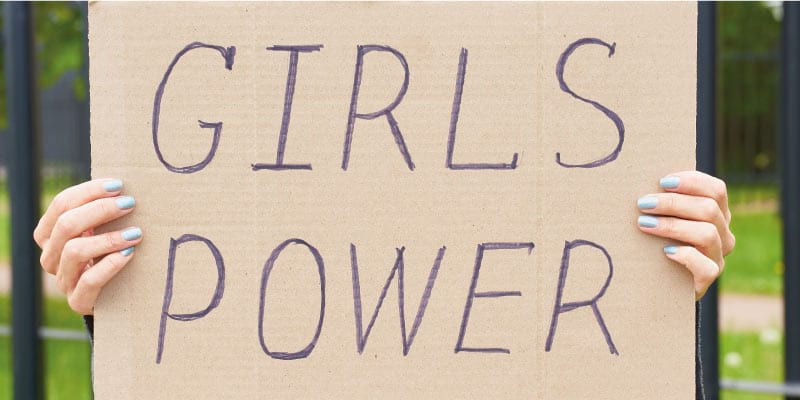Feminism explained including the definition

Feminism: in this article you will find a practical explanation on the topic of feminism, a political and social movement that seeks equal rights for women. After reading, you will understand this movement led by women.
What is feminism?
Feminism is a political and social movement that seeks to defend and achieve equal rights for women in their freedom, recognising the concern that social, cultural and economic aspects have been dominated by men since the beginning of humanity.
In the 18th century, the role of women and their rights was brough to the attention of the public with the publication of Mary Wollstonecraft’s A Vindication of the Rights of Woman in 1792. This work argues that women are not by nature inferior to men, and that lack of education leads to inequality and therefore inhumane treatment of women. This publication laid the foundations of modern feminism, making Wollstonecraft one of the most influential women in Europe at the time.
And so she began to strengthen feminism in the world, showing that women were not only to be seen as an object of adornment in marriage, nor in society in general. She was rethinking her position as a thinking being who should be seen on a par with their men at the time. This begins the debate on women’s rights within marriage, emphasising that women are human beings, therefore reasonable and deserving of the same fundamental rights as men.
Now you know what feminism is about and its central rationale. To be much more specific, we will give you the exact definition of its terminology.
Definition feminism
Feminism is the belief in social, economic and political gender equality. Much of its origin comes from the West. Feminism is manifested throughout the world, as it is represented by institutions and communities that are committed to defending the rights and interests of women, forming a collective in their defence.
Feminism focus
Feminism focuses on the role of patriarchy in structuring inequality between men and women, criticising the point of view of indoctrination on this matter, which is the practice of separating women and men in society. This is why feminism seeks to transform and seek equality for all.
Also as a social movement, it fights for women’s rights, such as giving a voice to all women who need to be heard in the field of civic and reproductive rights, and protecting women from sexual abuse, domestic violence, psychological abuse, among others.
In this article we will further break down the history, stages (waves), and thought-provoking examples of this issue.
History of feminism
The history of feminism is divided into stages, also known as waves. Each wave has managed to shape theories, evolve ideas, create strategies and build communities for feminism throughout significant moments in history.
It first began as individual revolutionary acts by women who disagreed with the rules imposed by the men of their time. The actions of these women were often shaped in the form of writings, more specifically essays in which they set out their thoughts on the disagreement with the treatment and the way they saw women.
One of these women who went against the stereotypes of medieval times was Christine de Pizan. She was a philosopher and writer of poems. From her profession she was able to support her family as an independent woman, as her husband Étienne du Castel died suddenly, leaving her a widow at the age of 25. Finding it difficult to support her children, she decided to write professionally for the nobility.
Her contribution to feminism was an individual but revolutionary act, as in 1399 she began writing about women’s rights, founding the group La Querelle de la Rose. This was a group formed by women to discuss access to education. This group lasted until the 17th century.
Her most popular work is The Treasure of the City of Ladies, which deals with the stories of enlightened women city builders. Pizan defends these women against the misogynistic arguments of other authors of the time. This work is an awakening and a cry of struggle in defence of women, something very revealing for the time, where the importance of men was superior, even more so if they came from families of renown.
The contributions on feminism of some women evolved, until they became waves of reference to the times.
First phase of feminism as a popular act: feminism and the enlightenment
One of the most important moments of feminism was in the French Revolution, when women’s clubs were formed and The Declaration of the Rights of Woman and of the Female Citizen (1791) was written by Olympe de Gouges, who proposed the emancipation of women.
This is one of the first documents to give meaning to equal rights, or the legal and juridical equality of women in relation to men.
Gouges opened the way for one of the precursors of feminism mentioned at the beginning: Mary Wollstonecraft, who established the basis of modern feminism with her work A Vindication of the Rights of Woman.
Second phase (first wave of feminism)
In the 19th and early 20th century, the first wave of the feminist movement developed in the United States, the United Kingdom and some Latin American countries.
Before that, it was focused on equal rights within marriage. At the end of the 19th century, it began to fight for political rights, property rights and in particular the right to suffrage, which is the right to vote.
In the 1830s and 1840s, the Peruvian Flora Tristan stood out in the French socialist movement, with works such as The Emancipation of Women, which led to the founding of the Suffragettes in the 20th century in the United Kingdom.
This was a group of women who were activists for women’s civic rights, particularly suffrage in the United States and the United Kingdom, advocating for equal rights. The Suffragettes held protests, hunger strikes, among other acts to raise their voices for equal civic rights.
At the same time as this was happening, a vital historical moment for humanity was the abolition of slavery. This was a moment of great significance for women, as many, including black women and white women workers, came together to make a revolutionary act that would go down in history.
The feminist movement united with the abolition of slavery to give a voice to women who had not been heard or even ignored during the time of slavery. One of the representative leaders of this time was Sojourne Truth, who is especially known for her speech ‘Ain’t I a Woman?’
Sojourne Truth was an activist and advocate for women’s rights. Born under the oppression of slavery, she managed to escape with her daughter in 1826, and filed a lawsuit against a white man in order to get her child back. She was the first black woman to win a lawsuit against a white man.
In this first wave, the struggle for equal rights for women was evident, as well as the defence of these rights, and the unattainable struggle to have a voice and a vote in society.
In 1918, the UK parliament voted about a law, more specifically the Representation of the People Act 1918. This resulted in woman receiving their right to vote, although it was limited to women over the age of 30, as long as they were landowners and had an annual lease of 5 pounds, or degrees from British universities. In 1928, this changed, as the conditions for men and women gradually became more equal.
This was not the only country to give women the vote. The first to do so was New Zealand in 1893, followed by Australia and Finland. Then the United States gave the right to vote to woman, which implemented women’s suffrage in 1919, at the end of World War II.
Second wave
In the first wave the focus was on overcoming the legal obstacles for women, e.g. equal rights in marriage and politics. In the second wave, however, issues such as inequality, sexuality and reproductive rights, family and the workplace were dealt with in greater depth.
In the Second World War, the advertisement “We can do it” became popular, which was made for the women of the time. This advertisement was about women who could replace their husbands in the factories while they were in battle. This advertising was criticised for being misleading, as it showed that woman could be equal to men, but actually were exploited in the workplace. After the war was over, women were sent back to their homes to continue the work in house.
Simone de Beauvoir, a French philosopher, professor and writer, was instrumental in this wave of feminism with the essay, The Second Sex in 1949. In it, she wrote about the situations in which women live with the inequality and lack of freedom, ruled by men.
This essay is considered to be the main reference work of the current feminism of equality. Many believe that for example women’s clothing adapted to what women thought and needed because of this essay. One of the forerunners in women’s fashion and its liberation was French designer Coco Chanel. Coco Chanel designed looser garments, shorter skirts and even popularised trousers for women, which was a scandal at the time, but liberating for women.
Then Betty Friedan’s book The Feminine Mystique was published, which was largely about how the traditional discourse of femininity hindered women’s intellectual engagement and active participation in society.
This wave opened up the way for women’s liberation, since apart from defending issues of equal rights in the labour and civic spheres, the rights and protection of reproductive sexuality also began to be important, which would have significant debates and moments in the third wave.
Third wave of feminism
In the third wave, the issue of gender and sex is at the forefront of women’s liberation. The woman decides about her body and what she does with it. The only thing which is relevant is what she wants and desires, no one else should be involved in her decisions.
There were also still other layers of oppression to be removed, such as class, racial and gender discrimination. With this, the third wave promoted the inclusion of all women, regardless of skin colour or social status, thus achieving a cultural inclusion that had not been seen in previous years.
In the 1990s, the debate focussed on racial inclusion which was vital in order to achieve advances in gender equality rights for all women. One of the most prominent women in this wave is Rebecca Walker, an American feminist writer and activist. She was the first feminist to refer to the third wave in her writings. She also touched on issues that focus on race, gender, politics, power and culture.
In the 1990s and 2000s feminism entered television with shows like Sex and the City that addressed issues of sexuality, female pleasure and women’s business empowerment. Women in the entertainment industry such as singer Madonna and actress Queen Latifah, among other powerful women in the industry, were also making their mark.
Giant steps forward for women and their position in society. It was now an open subject, not hidden and much more understood by society at large. The stereotypes of the submissive and emotional woman who had to be at home to take care of the household were falling away. In the 1990s, women opened their way academically, professionally and personally.
Fourth wave
It has been a long struggle for the defence of women’s equal rights, which is why we are now living the fourth wave, a struggle that continues to protect women.
The present is a time of denunciations of sexual harassment, violence against women and feminicides. Even after so many decades of struggle, today women are still defending the respect they should have and gender equality.
Social networks have been used as part of this feminist movement. One of them is the #Metoo and #Niunamenos movements used to defend women’s rights and denounce sexual abuse.
Women no longer want to remain silent and are using their voices and the power of technological advances to make public issues that were previously reserved or could not be touched because of fear. It also encourages the education of gender equality, respect for life and equal rights, as the reach that the internet now has can generate more reception, involving people from all over the world who reject social injustices.
Now It’s Your Turn
What do you think? Do you consider yourself a feminist? Do you think the fight for women’s equal rights has advanced or is it over? Do you have anything else to add or any suggestions?
Share your experience and knowledge in the comments box below.
More information
- Delmar, R. (2018). What is feminism?. In Theorizing feminism (pp. 5-28). Routledge.
- Gillis, S., Howie, G., & Munford, R. (Eds.). (2004). Third wave feminism. New York: Palgrave Macmillan.
- Walby, S. (2011). The future of feminism. Polity.
How to cite this article:
Ospina Avendano, D. (2021). Feminism. Retrieved [insert date] from Toolshero: https://www.toolshero.com/sociology/feminism/
Published on: 02/10/2021 | Last update: 03/30/2023
Add a link to this page on your website:
<a href=”https://www.toolshero.com/sociology/feminism/”>Toolshero: Feminism</a>












